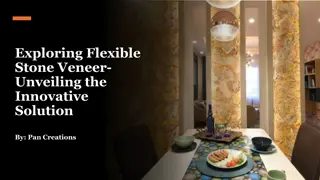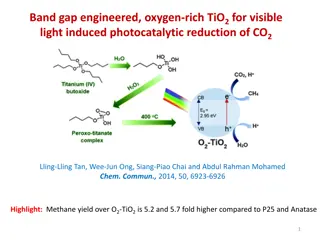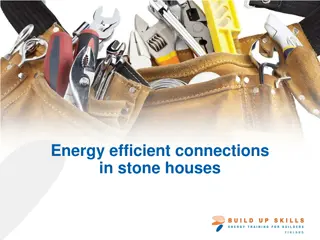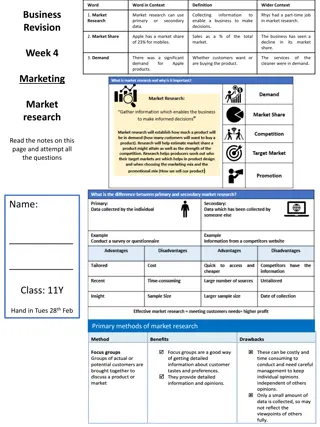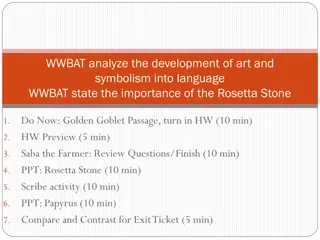Engineered Stone Market Assessment Report for A.St.A. World-Wide
A comprehensive assessment report prepared for A.St.A. World-Wide by Freedonia Custom Research, Inc. The report focuses on the global market environment, market size assessment, and competitive landscape of engineered stone products. It includes insights on the current situation, scope, definitions, and research methodology in analyzing the demand for engineered stone in construction and furniture industries across five global regions.
Download Presentation

Please find below an Image/Link to download the presentation.
The content on the website is provided AS IS for your information and personal use only. It may not be sold, licensed, or shared on other websites without obtaining consent from the author. Download presentation by click this link. If you encounter any issues during the download, it is possible that the publisher has removed the file from their server.
E N D
Presentation Transcript
World Engineered Stone Market Assessment Final Report Prepared for: March 4, 2015 Confidential Report Prepared on Behalf of A.St.A. World-Wide NOT FOR RE-USE
World Engineered Stone Market Assessment Table of Contents Introduction 3 Section I: Executive Summary 10 Section II: Market Environment 15 Section III: Market Size Assessment 21 Section IV: Engineered Stone Competitive Landscape 37 Prepared for A.St.A. World-Wide 2 Prepared by Freedonia Custom Research, Inc.
Introduction Prepared for A.St.A. World-Wide 3 Prepared by Freedonia Custom Research, Inc.
Introduction Current Situation World-Wide Agglomerated Stones Manufacturers Association (A.St.A.), a global association of agglomerated stone manufacturers, is aimed at promoting the development and progress of its member industries, and supporting the qualification of operators, industries, and their products and services. A.St.A. assists, safeguards and represents its member industries on issues affecting them directly or indirectly, promoting mutual collaboration among its members. A.St.A. endeavors to grow its membership into an international industry association, and therefore seeks a deeper understanding of the size of engineered stone markets construction and furniture uses for five global regions. In addition to an unbiased assessment of demand in each of these market segments, A.St.A. would like to better understand the number of firms in the world utilizing Breton, Keda or other proprietary technology and equipment in the production of engineered stone products. Prepared for A.St.A. World-Wide 4 Prepared by Freedonia Custom Research, Inc.
Introduction Scope and Definitions Product: End-Use Segments: Construction (flooring and wall covering) Furniture (kitchen countertops and bathroom vanities) * Note: There are no other uses for engineered stone. Engineered stone (including quartz, marble, sand, feldspar and other engineered stone) o For this report, only resin-based engineered stone was considered Time Series: 2014 and 2019 Geography: North America (US, Canada, Mexico) Central & South America Europe Africa & Middle East Asia/Pacific Units: Square meters Distribution Channels: Home Centers/Big-Box Retail Kitchen and Bath Specialty Retail Fabricator Direct Other Prepared for A.St.A. World-Wide 5 Prepared by Freedonia Custom Research, Inc.
Introduction Approach and Method Freedonia conducted primary and secondary research in order to gather data for analysis. Secondary sources were utilized to establish a set of baseline assumptions and estimates. Sources included: o Current Freedonia industry studies such as World Solid Surface & Other Cast Polymers, Solid Surface & Other Cast Polymers, World Residential Countertops, Countertops, World Countertops, Residential Kitchen & Bath Countertops in China, World Flooring & Carpets, Hard Surface Flooring and World Construction Outlook o Freedonia consensus economic forecasts o Industry and trade publications/associations o Local and national press o Marketing literature and press releases o Investment analyst presentations o Company financial filings Discussion guides were developed and employed for interviews across industry constituent groups. o Primary research was aimed at gathering qualitative insights as well as challenging/validating quantitative assumptions and estimates developed during the course of the study. Prepared for A.St.A. World-Wide 6 Prepared by Freedonia Custom Research, Inc.
Introduction Approach and Method (continued) Freedonia conducted more than 45 interviews with companies across all industry constituent groups in order to gather broad perspectives and particular data points on the engineered stone market in each region and end-use segment within the scope of the assessment. The following industry constituent groups were interviewed during the course of the project: Engineered stone producers/manufacturers Engineered stone fabricators/converters Other distribution channels Prepared for A.St.A. World-Wide 7 Prepared by Freedonia Custom Research, Inc.
Introduction List of Respondent Companies Engineered Stone Producers/Manufacturers (31): Antiqua Ceramic Asian Granito India (2) Bitto Industry (Dongguan) Cimstone Classic Marble Company (Kalingastone) Compac Cosentino Deepan International Euro Ceramic Guangzhou Gelandi Polymer Material Gulf Stone Company Hanwha L&C Heshan Nande Quartz Stone Hubei Saiz Stone LLC Zavod Kompozitnikh Materialov (Plaza Stone) Marmi Scala Oppein Home Group Peker Y zey Tasarimlari Sanayi ve Ticaret A. (Belenco) Pokarna (2) Safayar Ceramics Santa Margherita Seieffe Shiva Export Sino Stone Wenzhou Weien Building Decoration Materials Technistone Technostone Vietnam Quartz Stone (Vinaquartz) Wanfeng Compound Stone Technology Engineered Stone Fabricators/Distributors (12): Agilex Marmores GMG Stone Lobo Stone Bench-Tops Mardil MSI International Polo Marmores Machinery Manufacturers (4): Breton (2) Foshan Shuoyu Machinery R&D Keda Clean Energy ProSource Wholesale (2) Shivdhara Marbo Group Sri Sai Kripa Group Tradecraft Australia WK Marble & Granite Other Respondents (2): Bao Loc Investment Construction (Former Mfr) International Surface Fabricators Association Prepared for A.St.A. World-Wide 8 Prepared by Freedonia Custom Research, Inc.
Introduction Notes Annual growth throughout this report is expressed in compounded annual growth rates (CAGR) calculated between 2014 and 2019. All demand figures are reported in square meters unless otherwise noted. Segmented estimates may not add to totals shown due to rounding. o Demand estimates are generally rounded to 2.5 significant digits. o CAGR percentages are rounded to 3 significant digits. Prepared for A.St.A. World-Wide 9 Prepared by Freedonia Custom Research, Inc.
Section I Executive Summary Prepared for A.St.A. World-Wide 10 Prepared by Freedonia Custom Research, Inc.
Executive Summary Market Size Assessment Chart I-1 Chart I-2 Engineered Stone Production Share by Region, 2014 (47 million square meters) Engineered Stone Demand* Share by Region, 2014 (44.5 million square meters) Central & South America 0.5 1% Asia/Pacific 21.5 46% North America 7.5 17% Africa & Middle East 4.3 9% Asia/Pacific 26.5 59% Europe 8.4 19% North America 4.1 9% Europe 17.0 36% Central & South America 0.0 0% Africa & Middle East 1.7 4% Approximately 47 million square meters of engineered stone were produced in 2014 across four regions: Asia/Pacific, Europe, Africa and the Middle East, and North America. Among these regions, Asia/Pacific was the largest producer, accounting for 46% of global manufacturing. Europe represented the second-largest region for production at 36%. Both Africa/Middle East and North America had shares of 9%, though the former produced slightly more engineered stone than the latter. Similar to production, Asia/Pacific leads all in-scope regions in engineered stone demand in 2014, representing nearly 60% of the global 44.5 million square meter demand total. Europe and North America accounted for the second- and third-largest regions for demand with approximately 19% and 17%, respectively. The remaining 4% was comprised primarily of Africa and the Middle East, while Central and South America accounted for just 1% of global demand. *Demand assumes 2.5 million square meters of produced engineered stone not sold by manufacturers in Asia/Pacific. Prepared for A.St.A. World-Wide 11 Prepared by Freedonia Custom Research, Inc.
Executive Summary Market Size Assessment (continued) Chart I-3 Engineered Stone Demand by Application, 2014 (44.5 million square meters) 9.1 Asia/Pacific 17.5 0.5 Africa & Middle East 1.2 2.3 Europe Construction 6.1 Furniture 0.0 Central & South America 0.4 1.2 North America 6.4 0.0 2.0 4.0 6.0 8.0 10.0 12.0 14.0 16.0 18.0 20.0 In every region during 2014, furniture applications were the predominate end-use for engineered stone. In total, furniture which consists of countertops and vanities accounted for 31.5 million square meters, representing approximately 70% of all demand. Construction end-uses comprised the remaining 30% of engineered stone demand in 2014. Only two regions saw construction applications represent 30% or more of demand: Asia/Pacific and Africa and the Middle East. Asia/Pacific had the largest market for construction and furniture applications in 2014, largely due to the size of the market overall. Prepared for A.St.A. World-Wide 12 Prepared by Freedonia Custom Research, Inc.
Executive Summary Market Size Assessment (continued) Chart I-4 Engineered Stone Demand by Distribution Channel, 2014 (43.5 million square meters) 2.0 18.0 Asia/Pacific 5.7 0.9 0.1 0.4 Africa & Middle East 1.2 0.0 Home Centers/Big-Box Retail 1.3 2.9 Europe Kitchen & Bath Specialty Retail 4.0 0.3 Fabricator Direct 0.1 Other 0.0 Central & South America 0.3 0.0 2.9 1.5 North America 3.0 0.2 0.0 2.0 4.0 6.0 8.0 10.0 12.0 14.0 16.0 18.0 20.0 In 2014, the largest channel for sales of engineered stone was kitchen and bath specialty retail, accounting for 22.5 million square meters, which is approximately 51% of demand. Much of these sales occurred in the Asia/Pacific market (18 million square meters), where engineered stone is primarily sourced from smaller kitchen stores and decoration companies. The fabricator direct channel accounted for, in total, 14 million square meters (32%) in 2014. This channel was the most popular choice in every region except Asia/Pacific. Home centers/big-box retail was the third largest channel for engineered stone sales in 2014, representing 6.3 million square meters. This channel, while present in every region, only made a significant different in North America (2.9 million square meters), where chains such as Home Depot and Lowe s are prevalent. Prepared for A.St.A. World-Wide 13 Prepared by Freedonia Custom Research, Inc.
Executive Summary Engineered Stone Competitive Landscape Chart I-5 Chart I-6 Engineered Stone Manufacturers by Region, 2014 (186 companies) Engineered Stone Production by Region, 2014 (47 million square meters) 100% 90% North America 4 2% Asia/Pacific 21.5 80% 70% 60% Europe 16 9% Africa & Middle East, 4.3 Asia/Pacific 161 86% 50% 40% Europe 17.0 30% 20% Africa & Middle East 5 3% 10% North America 4.1 0% Production In 2014, there were approximately 186 identified manufacturers of engineered stone worldwide. The largest concentration of companies was in the Asia/Pacific region, with 86% of worldwide production operations; China accounted for roughly 86% of those establishments. The region of Africa and the Middle East, as well as the North American region, each produced roughly 9% of engineered stone globally in 2014. Both regions have similar numbers of active manufacturers. As of 2014, there was no manufacturing of engineered stone in Central and South America. Prepared for A.St.A. World-Wide 14 Prepared by Freedonia Custom Research, Inc.
Section II Market Environment Prepared for A.St.A. World-Wide 15 Prepared by Freedonia Custom Research, Inc.
Market Environment North America Table II-1 North America Market Indicators CAGR % 19/14 Item 2014 2019 Gross Domestic Product (bil US 2013$) Personal Consumption Expenditures (bil US 2013$) Population (million people) 20,790 14,109 476 26,990 15,973 497 5.4 2.5 0.9 Households (million units) New Housing (thousand units) Residential Building Construction Expenditures (bil US 2013$) Nonresidential Building Construction Expenditures (bil US 2013$) 169 180 1.3 5.6 7.3 5.3 2,147 699 391 2,819 994 506 Source: Freedonia Custom Research, Inc. Real GDP in North America is forecast to rise 5.4% per annum through 2019. Personal Consumption Expenditures are expected to grow at 2.5% per annum through 2019. New housing units are projected to grow by 5.6% per year over the 2014-2019 period, with the US per annum growth of 8.8% outpacing overall growth, as well as contributing 84% of the unit growth. Both residential and nonresidential building construction are expected to post strong gains. The US is driving residential building expenditure growth at 8.6% per year, contributing almost 90% of the growth in spending. These gains reflect a continuation of the US housing recovery that began in 2011. Nonresidential growth will be driven by businesses seeking new facilities or upgrades of existing ones to increase production as general economic activity increases. Prepared for A.St.A. World-Wide 16 Prepared by Freedonia Custom Research, Inc.
Market Environment Central & South America Table II-2 Central & South America Market Indicators CAGR % 19/14 Item 2014 2019 Gross Domestic Product (bil US 2013$) Personal Consumption Expenditures (bil US 2013$) Population (million people) 7,155 4,567 497 8,295 5,271 522 3.0 2.9 1.0 Households (million units) New Housing (thousand units) Residential Building Construction Expenditures (bil US 2013$) Nonresidential Building Construction Expenditures (bil US 2013$) 143 155 1.7 3.2 4.1 3.4 3,926 217 275 4,586 265 324 Source: Freedonia Custom Research, Inc. GDP growth in the region is forecast to be 3% per annum, with Peru having the fastest growth. Brazil, the region s largest economy, will account for the largest share of growth over the 2014-2019 time period. Briskresidential construction growth throughout the region will be buoyed by growing populations, rising wages and improved standards of living in this region. Brazil will account for 36% of the residential construction spending increase during this time period. Nonresidential building construction expenditures will increase by 3.4% per annum from 2014 to 2019. Brazil will drive growth, accounting for 31% of the increased nonresidential construction expenditures from 2014 to 2019. Prepared for A.St.A. World-Wide 17 Prepared by Freedonia Custom Research, Inc.
Market Environment Europe Table II-3 Europe Market Indicators CAGR % 19/14 Item 2014 2019 Gross Domestic Product (bil US 2013$) Personal Consumption Expenditures (bil US 2013$) Population (million people) 22,905 13,126 740 25,075 15,451 742 1.8 3.3 0.0 Households (million units) New Housing (thousand units) Residential Building Construction Expenditures (bil US 2013$) Nonresidential Building Construction Expenditures (bil US 2013$) 312 319 0.4 1.8 2.3 2.4 2,577 925 621 2,812 1,034 699 Source: Freedonia Custom Research, Inc. Real GDP in Europe is forecast to rise 1.8% per annum through 2019, while the European resident population is expected to have minimal growth. Personal Consumption Expenditures are expected to grow at 3.3% per annum through 2019. Western Europe will drive 70% of the five-year expenditures increase, and will also experience slightly faster growth per annum than Eastern Europe. Residential Building Construction Expenditures are forecast to grow by 2.3% per year over the 2014-2019 period. Growth will be mixed in Europe. France is projected to lead with per annum growth of 3.4%, accounting for 19% of the continent s growth, while Germany s expenditures will decline by -1.6% per year. Nonresidential growth in Europe will be supported by rebounds from depressed 2013 levels. Prepared for A.St.A. World-Wide 18 Prepared by Freedonia Custom Research, Inc.
Market Environment Africa & Middle East Table II-4 Africa & Middle East Market Indicators CAGR % 19/14 Item 2014 2019 Gross Domestic Product (bil US 2013$) Personal Consumption Expenditures (bil US 2013$) Population (million people) 12,380 6,575 1,460 15,010 8,036 1,625 3.9 4.1 2.2 Households (million units) New Housing (thousand units) Residential Building Construction Expenditures (bil US 2013$) Nonresidential Building Construction Expenditures (bil US 2013$) 350 407 3.1 3.7 4.7 3.9 10,393 476 520 12,458 599 628 Source: Freedonia Custom Research, Inc. Despite the fall in the price of oil and civil strife in several countries in the Middle East, the region s largest economies Turkey and Saudi Arabia are set to grow between 3.8% to 3.9% respectively per year from 2014 to 2019. Similarly, growth in Israel is forecast to grow by 3.2% per year over this time period. Residential construction growth will increase 4.7% per annum from 2014 to 2019. Turkey will contribute the most to the overall expenditure gain, accounting for 17% of the total increase during this time period. Building of new housing for rural-to-urban migrants will fuel the region s growth. Nonresidential building construction will increase by 3.9% per annum from 2014 to 2019. Saudi Arabia will lead the region, accounting for 19% of the overall nonresidential spending increase. Prepared for A.St.A. World-Wide 19 Prepared by Freedonia Custom Research, Inc.
Market Environment Asia/Pacific Table II-5 Asia/Pacific Market Indicators CAGR % Item 2014 2019 19/14 Gross Domestic Product (bil US 2013$) Personal Consumption Expenditures (bil US 2013$) Population (million people) 42,470 20,661 4,020 55,330 27,371 4,195 5.4 5.8 0.9 Households (million units) New Housing (thousand units) Residential Building Construction Expenditures (bil US 2013$) Nonresidential Building Construction Expenditures (bil US 2013$) 1,051 34,200 2,825 2,885 1,106 39,500 3,828 3,992 1.0 2.9 6.3 6.7 Source: Freedonia Custom Research, Inc. The region s two largest economies, China and India, are set to lead the region in economic growth over the period 2014 to 2019, with projected annual growth rates of 6.7% and 6.4% respectively. Rising incomes in China and India, as well as in several smaller Asian economies, will spur strong consumer spending in the region. Residential and non-residential construction will outpace overall economic growth in most Asian economies. Residential growth will be driven by demographic trends and rising incomes that will continue to support gains in residential building construction activity in the region. Chinese residential construction spending is projected to grow by 7.6% per annum and will contribute to 77% of the overall increase. China s non-residential spending growth of 7.8% will also outpace the region s expenditure growth . Prepared for A.St.A. World-Wide 20 Prepared by Freedonia Custom Research, Inc.
Section III Market Size Assessment Prepared for A.St.A. World-Wide 21 Prepared by Freedonia Custom Research, Inc.
Market Size Assessment Summary Production of engineered stone, globally, totaled 47 million square meters in 2014. It is expected that manufacturing will continue to grow through the forecast period to support growing demand. In 2019, production is expected to hit 78.5 million square meters. Asia/Pacific is projected to see 14.1% annual growth from 2014 to 2019, expanding to 42 million square meters from 21.5 millions square meters. China has had many manufacturers establish themselves over the last several years, and currently, the region has a very low capacity utilization rate (41%) due to low domestic pricing and a competitive export market. World demand for engineered stone totaled 44.5 million square meters in 2014. It is projected to climb 11.2% annually through 2019 to 75.5 million square meters. Asia/Pacific accounted for the largest portion of demand in 2014 with 26.5 million square meters. Over the forecast period, it will remain the largest region globally. Growth will be supported by an increasing use of engineered stone in construction applications, as well as increased income levels and construction expenditures. o Approximately 2.5 million square meters remains unsold to end-use markets and is carried as inventory by manufacturers and fabricators in Asia/Pacific. Furniture applications, such as countertops and vanities, were the largest end-use category of engineered stone demand in 2014, accounting for approximately 70%. The remaining portion of demand (30%) was for products used in construction applications, such as wall cladding and flooring. Largely, construction applications for engineered stone were found in the Asia/Pacific region, but the end-use also had a substantial presence in Africa and the Middle East. In 2014, the largest channel for sales of engineered stone was kitchen and bath specialty retail, accounting for 22.5 million square meters, or approximately 51% of demand. Much of these sales occurred in the Asia/Pacific market, where engineered stone is primarily sourced from smaller kitchen stores and decoration companies. Prepared for A.St.A. World-Wide 22 Prepared by Freedonia Custom Research, Inc.
Market Size Assessment Engineered Stone Production World Production of engineered stone, globally, totaled 47 million square meters in 2014. It is expected that production will continue to grow through the forecast period to support growing demand. Production in 2019 is expected to hit 78.5 million square meters. Asia/Pacific is projected to see 14.1% annual growth from 2014 to 2019, expanding to 42 million square meters from 21.5 millions square meters. China has had many manufacturers establish themselves over the last several years, and currently, the region has a very low capacity utilization rate (41%) due to low domestic pricing and a competitive export market. The Asia/Pacific region is the only region that is not selling all of its production. North American production, completely supported by Breton machines, will see the second fastest growth over the forecast period, totaling 6.5 million in 2019 after climbing nearly 10% annually from 2014. Caesarstone s announced plant in Atlanta will increase the number of active manufacturers in the region in 2015, and current producers are also planning to increase their capacity over the forecast period. The European production climate, largely Breton- supported, is expected to grow its production by 7.5 million square meters from 2014 to 2019, expanding at 8.1% per annum, as companies begin to utilize more of their capacity, and demand abroad continues to grow. Production levels in Africa and the Middle East are expected to increase 4.3% per year through 2019, climbing to 5.3 million square meters. Table III-1 World Engineered Stone Production (million square meters) CAGR % Item 2014 2019 19/14 World Production North America Central & South America Europe Africa & Middle East Asia/Pacific 47.0 4.1 78.5 6.5 10.9 9.9 -- -- -- 17.0 4.3 21.5 24.5 5.3 42.0 8.1 4.3 14.1 Source: Freedonia Custom Research, Inc. Prepared for A.St.A. World-Wide 23 Prepared by Freedonia Custom Research, Inc.
Market Size Assessment Engineered Stone Demand World World demand for engineered stone totaled 44.5 million square meters in 2014. It is projected to climb 11.2% annually through 2019 to 75.5 million square meters. Asia/Pacific accounted for the largest portion of demand in 2014 with 26.5 million square meters. Over the forecast period, it will remain the largest region globally. Growth will be supported by an increasing use of engineered stone in construction applications, as well as increased income levels and construction expenditures. North America will also see rapid growth to 2019, expanding from 7.5 million square meters to 13.5 square meters. Increasing popularity of engineered stone over less-durable natural stone products will be a driving factor of the increased demand. Europe will see 10.4% growth in engineered stone demand per annum from 2014 to 2019, despite its economic difficulties, as northern countries including the United Kingdom and Germany, as well as Eastern European nations, continue to adopt the material. Demand within Africa and the Middle East will largely benefit from countries with local production such as Israel and Turkey, expanding 6.3% annually to total 2.3 million square meters in 2019. However, the price of engineered stone acts as a deterrent for further growth. Central and South America will remain a negligible region for engineered stone demand, with pricing and economic climates hindering further growth. Table III-2 World Engineered Stone Demand (million square meters) CAGR % Item 2014 2019 19/14 World Demand North America Central & South America Europe Africa & Middle East Asia/Pacific 44.5 7.5 0.5 8.4 1.7 26.5 75.5 13.5 0.6 13.5 2.3 45.5 11.2 12.2 5.5 10.4 6.3 11.5 Source: Freedonia Custom Research, Inc. *Demand assumes 2.5 million square meters of produced engineered stone not sold by manufacturers in Asia/Pacific in 2014. This trend of overproducing is expected to remain in Asia/Pacific through 2019. Prepared for A.St.A. World-Wide 24 Prepared by Freedonia Custom Research, Inc.
Market Size Assessment Engineered Stone Demand by End-Use World Table III-3 World Engineered Stone Demand by End-Use (million square meters) Item 2014 World Demand Construction Furniture 44.5 13.0 31.5 Source: Freedonia Custom Research, Inc. Furniture applications, such as countertops and vanities, were the largest end-use category of engineered stone demand in 2014, accounting for approximately 70%. It is worth noting that engineered stone sinks are offered for an integrated, seamless appearance with a countertop or vanity, though demand is fairly low globally for these products. Since these products are sold alongside countertops or vanities, sinks are included within the figures for furniture applications. The remaining portion of demand (30%) was for products used in construction applications, such as wall cladding or flooring. Largely, this portion of demand was found in the Asia/Pacific region, but Africa and the Middle East also had substantial demand. Prepared for A.St.A. World-Wide 25 Prepared by Freedonia Custom Research, Inc.
Market Size Assessment Engineered Stone Demand by End-Use North America Table III-4 North America Engineered Stone Demand by End-Use (million square meters) Item 2014 World Demand % North America 44.5 16.9% North America Demand Construction Furniture 7.5 1.2 6.4 Source: Freedonia Custom Research, Inc. Furniture applications in North America held approximately 85% of total engineered stone demand in 2014, totaling 6.4 million square meters. Construction held the remaining 15% of demand with 1.2 million square meters. The focus on furniture applications is partially due to marketing initiatives by countertop manufacturers, rather than an incompatibility of the material for construction purposes. It is expected that new residential countertops will be the driving end-use for engineered stone demand in North America over the next several years. Prepared for A.St.A. World-Wide 26 Prepared by Freedonia Custom Research, Inc.
Market Size Assessment Engineered Stone Demand by End-Use Central & South America Table III-5 Central & South America Engineered Stone Demand by End-Use (million square meters) Item 2014 World Demand % Central & South America 44.5 1.0% Central & South America Demand Construction Furniture 0.5 0.0 0.4 Source: Freedonia Custom Research, Inc. Furniture applications accounted for 90% of engineered stone demand in Central and South America in 2014, for a total of approximately 400,000 square meters in 2014. Construction applications represented the remaining 10%, but totaled less than 100,000 square meters. The price of the material is a deterrent for construction applications. Prepared for A.St.A. World-Wide 27 Prepared by Freedonia Custom Research, Inc.
Market Size Assessment Engineered Stone Demand by End-Use Europe Table III-6 Europe Engineered Stone Demand by End-Use (million square meters) Item 2014 World Demand % Europe 44.5 18.8% Europe Demand Construction Furniture 8.4 2.3 6.1 Source: Freedonia Custom Research, Inc. In Europe, furniture applications of engineered stone comprised the majority of demand in 2014, totaling approximately 6.1 million square meters. Construction accounted for the remaining 2.3 million square meters. The chief application of engineered marble is flooring and wall cladding. It is not as suitable for countertop and vanities as engineered quartz, which is a more durable material. Penetration of quartz in Eastern Europe is constrained by its high price relative to other engineered stone products. Prepared for A.St.A. World-Wide 28 Prepared by Freedonia Custom Research, Inc.
Market Size Assessment Engineered Stone Demand by End-Use Africa & Middle East Table III-7 Africa & Middle East Engineered Stone Demand by End-Use (million square meters) Item 2014 World Demand % Africa & Middle East 44.5 3.7% Africa & Middle East Demand Construction Furniture 1.7 0.5 1.2 Source: Freedonia Custom Research, Inc. Total demand for engineered stone in Africa and the Middle East in 2014 was 1.7 million square meters. Approximately 70% of total demand was used in furniture applications, accounting for 1.2 million square meters. The remaining 500,000 square meters were used in construction applications. The price of engineered stone generally dissuades end-users from purchasing the material for use in flooring and wall-cladding. Prepared for A.St.A. World-Wide 29 Prepared by Freedonia Custom Research, Inc.
Market Size Assessment Engineered Stone Demand by End-Use Asia/Pacific Table III-8 Asia/Pacific Engineered Stone Demand by End-Use (million square meters) Item 2014 World Demand % Asia/Pacific 44.5 59.6% Asia/Pacific Demand Construction Furniture 26.5 9.1 17.5 Source: Freedonia Custom Research, Inc. Furniture was the leading end-use for engineered stone in 2014. Construction applications accounted for its largest share among global regions in Asia/Pacific, where it represented 34% of all demand. Much of this was in India and China, where flooring and wall-cladding with engineered marble (and to a lesser extent, quartz) were much more common than in other regions. Prepared for A.St.A. World-Wide 30 Prepared by Freedonia Custom Research, Inc.
Market Size Assessment Engineered Stone Demand by Channel World Table III-9 World Engineered Stone Demand by Channel (million square meters) Item 2014 World Demand Home Centers/Big-Box Retail Kitchen & Bath Specialty Retail Fabricator Direct Other 44.5 6.3 22.5 14.0 1.4 Source: Freedonia Custom Research, Inc. In 2014, the largest channel for sales of engineered stone was kitchen and bath specialty retail, accounting for 22.5 million square meters, or approximately 51% of demand. Much of these sales occurred in the Asia/Pacific market, where engineered stone is primarily sourced from smaller kitchen stores and decoration companies. The fabricator direct channel accounted for 14 million square meters (32%) in 2014. This channel was the most popular choice in every region except Asia/Pacific. Home centers/big-box retail was the third largest channel for engineered stone sales in 2014, representing 6.3 million square meters. This channel, while present in every region, only made a significant difference in North America, where chains such as Home Depot and Lowes are prevalent. Prepared for A.St.A. World-Wide 31 Prepared by Freedonia Custom Research, Inc.
Market Size Assessment Engineered Stone Demand by Channel North America Table III-10 North America Engineered Stone Demand by Channel (million square meters) Item 2014 World Demand % North America 44.5 16.9% North America Demand Home Centers/Big-Box Retail Kitchen & Bath Specialty Retail Fabricator Direct Other 7.5 2.9 1.5 3.0 0.2 Source: Freedonia Custom Research, Inc. In 2014, North American end-users most commonly purchased their engineered stone directly from fabricators. The channel accounted for approximately 40% of total demand. Additionally, the consensus during primary interviews was that home centers/big-box retailers and kitchen and bath specialty retail were the second and third largest channels, respectively. Home centers and big-box retail account for roughly 38% of demand in North America, the largest this channel holds among regions globally. This is largely due to the popularity of establishments such as Home Depot and Lowe s throughout the region. Prepared for A.St.A. World-Wide 32 Prepared by Freedonia Custom Research, Inc.
Market Size Assessment Engineered Stone Demand by Channel Central & South America Table III-11 Central & South America Engineered Stone Demand by Channel (million square meters) Item 2014 World Demand % Central & South America 44.5 1.0% Central & South America Demand Home Centers/Big-Box Retail Kitchen & Bath Specialty Retail Fabricator Direct Other 0.5 0.1 0.0 0.3 0.0 Source: Freedonia Custom Research, Inc. The majority (70%) of engineered stone sold in Central and South America was sourced directly from fabricators in 2014, totaling approximately 300,000 square meters. The region has a high number of fabrication establishments for purchasing the in-scope products. Home centers/big-box retail was the only other significant channel roughly 100,000 square meters were sold through those establishments in 2014. Kitchen and bath specialty retail were categorized as primarily selling countertops made with lower-priced materials, making this an infrequent channel for the purchase of engineered stone. Prepared for A.St.A. World-Wide 33 Prepared by Freedonia Custom Research, Inc.
Market Size Assessment Engineered Stone Demand by Channel Europe Table III-12 Europe Engineered Stone Demand by Channel (million square meters) Item 2014 World Demand % Europe 44.5 18.8% Europe Demand Home Centers/Big-Box Retail Kitchen & Bath Specialty Retail Fabricator Direct Other 8.4 1.3 2.9 4.0 0.3 Source: Freedonia Custom Research, Inc. In 2014, European end-users were most likely to purchase engineered stone directly from fabricators; the channel represented nearly half of all demand. In Eastern Europe specifically, fabricator-direct sales accounted for over half of demand for engineered stone. Home centers and big-box retail locations represented 15% of demand in 2014, lagging behind kitchen and specialty bath retail. Western Europe was where the majority of purchases from this channel occurred, as Eastern Europe only saw approximately 6% of all engineered stone sold through this channel. Prepared for A.St.A. World-Wide 34 Prepared by Freedonia Custom Research, Inc.
Market Size Assessment Engineered Stone Demand by Channel Africa & Middle East Table III-13 Africa & Middle East Engineered Stone Demand by Channel (million square meters) Item 2014 World Demand % Africa & Middle East 44.5 3.7% Africa & Middle East Demand Home Centers/Big-Box Retail Kitchen & Bath Specialty Retail Fabricator Direct Other 1.7 0.1 0.4 1.2 0.0 Source: Freedonia Custom Research, Inc. Demand for engineered stone in Africa and the Middle East was 1.7 million square meters in 2014. The demand split between channels was similar to Europe as a whole, with fabricator direct accounting for 70% of demand, followed by kitchen and bath specialty retail and home centers/big-box retail. Home centers/big-box retail saw its lowest share of demand within this region, due to the lack of penetration of these companies within the Africa/Middle East market. Prepared for A.St.A. World-Wide 35 Prepared by Freedonia Custom Research, Inc.
Market Size Assessment Engineered Stone Demand by Channel Asia/Pacific Table III-14 Asia/Pacific Engineered Stone Demand by Channel (million square meters) Item 2014 World Demand % Asia/Pacific 44.5 59.6% Asia/Pacific Demand Home Centers/Big-Box Retail Kitchen & Bath Specialty Retail Fabricator Direct Other 26.5 2.0 18.0 5.7 0.9 Source: Freedonia Custom Research, Inc. Asia/Pacific has the largest portion of worldwide demand for the kitchen and bath specialty retail, with a share of approximately 68%. Much of this is in China, where the majority of engineered stone purchases are from small kitchen and decoration companies. Home centers and big box retail locations are the smallest among in-scope channels. Their presence in Asia/Pacific is largely in India, which accounts for the majority of demand through that channel. Prepared for A.St.A. World-Wide 36 Prepared by Freedonia Custom Research, Inc.
Section IV Engineered Stone Competitive Landscape Prepared for A.St.A. World-Wide 37 Prepared by Freedonia Custom Research, Inc.
Engineered Stone Competitive Landscape Manufacturer Count and Share of Production by Region Table IV-1 Chart IV-1 Production Share by Region (47 million square meters) Engineered Stone Manufacturers by Region, 2014 Number of Manufacturers* Share of Total Asia/Pacific 46% Item World North America Central & South America Europe Africa & Middle East Asia/Pacific 186 Africa & Middle East 9% 4 -- 16 5 161 2% -- 9% 3% 86% North America 9% Europe 36% Central & South America 0% Source: Freedonia Custom Research, Inc. * full list of producers by region available in Excel file In 2014, there were approximately 186 indentified manufacturers of engineered stone worldwide. The largest concentration of companies was in the Asia/Pacific region; China accounted for roughly 86% of these establishments. While the region possesses the largest share of manufacturers, the level of capacity utilization is lowest among all in-scope regions. However, although Asia/Pacific holds the top share in level of production, in general, European manufacturers possess much higher capacity levels and higher rates of utilization. Europe accounts for the second-largest level of production globally with 36%. Africa and the Middle East, as well as North America, each produced roughly 9% of engineered stone globally in 2014. Both regions have a similar number of active manufacturers. As of 2014, there is no manufacturing of engineered stone in Central and South America. Prepared for A.St.A. World-Wide 38 Prepared by Freedonia Custom Research, Inc.
Engineered Stone Competitive Landscape Comparison of Breton Machinery and Chinese Machinery Generally, the engineered stone market is divided into two distinct groups those manufactured using Breton technology, and those using Chinese technology. It is generally accepted that Keda and other Chinese equipment manufacturers copied Breton machinery to produce their own, though with an inferior level of performance. Chinese machinery is not fully automated, unlike its Breton counterpart, and is unable to process as much engineered stone as quickly as Breton equipment. However, because of the sheer number of manufacturers in China, the amount of stone being produced is very high and competes using low prices in comparison to Breton-made engineered stone. Opinions regarding the quality of the engineered stone are split among respondents. Several distributors in North America commented that several brands of Chinese engineered stone, notably Quartz Source, are indistinguishable from Breton-manufactured stone. However, many believe the product to be inferior in build quality, and claimed that it could not compete in the international market. Production of engineered stone using Chinese-manufactured equipment occurs in four countries: China, India, Vietnam and South Korea. Radianz, by Samsung, is thought to be the most recognizable brand of Keda-manufactured engineered stone. Keda is one of many different brands of Chinese equipment used in engineered stone production. It is thought that there are as many as 20 different machinery manufacturers. Non-Breton manufactured stone is primarily sold in the Asia/Pacific region, though some manufacturers within the region ship their products to North America, which are then often sold under private labels. Other destinations include Europe, and Africa/Middle East. Prepared for A.St.A. World-Wide 39 Prepared by Freedonia Custom Research, Inc.
Engineered Stone Competitive Landscape Insights on Chinese Production Keda Clean Energy manufactures machinery for use in the production of engineered stone. The company claims to have begun selling its production equipment in 2009, and that its annual sales of manufacturing lines are less than 5 units. Additionally, the company claims it has exported its machinery to South Korea and India, and that Chinese manufacturers primarily use domestic machinery due to competitive pricing. We are not the largest stone machinery supplier in China. There are [several equipment manufacturers in China], and most of them are small. Keda interview Keda commented that their production machinery is semi-automatic compared to Breton s machinery, which is fully automatic. It manufactures two separate lines one for artificial quartz and the other for artificial marble. According to the company s website, Keda quartz machinery possesses a capacity not lower than 400,000 square meters annually when the machine is run 20 hours per day. It produces a range of thicknesses between 10 and 30 millimeters, and has a maximum processing size of 3.29 by 1.65 meters. Keda s line for engineered marble can produce approximately 1-1.5 pieces of engineered marble per hour, and has four distinct output sizes. o 3.05 by 1.25 meters, with an 850 millimeter thickness o 3.25 by 1.25 meters, with an 850 millimeter thickness o 2.45 by 1.65 meters, with an 850 millimeter thickness Prepared for A.St.A. World-Wide o 2.45 by 1.85 meters, with an 850 millimeter thickness. 40 Prepared by Freedonia Custom Research, Inc.
Engineered Stone Competitive Landscape Asia/Pacific Manufacturing Overview China In 2014, more than 130 companies produced engineered stone in China. Many of these manufacturers were small operations, and many of them were established in the last several years. According to primary research, the Guangdong province used to house engineered stone manufacturers exclusively, but more production has opened up to other provinces, such as Shandong, Fujian and Hubei. Nearly every Chinese engineered stone producer uses a domestic machine based roughly on the Breton equipment design. o Engineered stone manufacturers estimated that there are approximately 10-20 different machinery manufacturers in China, including the more well-known Keda Clean Energy and Foshan Shuoyu Machinery R&D products. o Manufacturers consider Breton equipment to be too expensive to use, many claiming they could not afford to do business if they utilized Breton machinery. Furthermore, because the machines are not fully automatic, the cheap price of labor in China also is a factor in the use of inexpensive domestic machines. o Comparatively, Chinese machines use more resin in their engineered stone than their Breton counterparts. Because of the international perspective on the quality of their products, Chinese manufacturers of engineered stone primarily serve domestic demand, although Chinese end-users are known to use products from other regions as well. Recently, more Chinese products are being sold in North America under private labels. Prepared for A.St.A. World-Wide 41 Prepared by Freedonia Custom Research, Inc.
Engineered Stone Competitive Landscape Asia/Pacific Manufacturing Overview Vietnam Prior to 2014, the Vietnamese engineered stone industry was more robust, with five to six significant players in the space. However, in 2014, only three companies were identified as being active in manufacturing resin- based engineered stone: Vicostone/Style Stone, Vicaquartz and Royal Stone, with Vicostone/Style Stone accounting for the largest share of production. Vicostone and Style Stone are both part of Vinaconex Corporation, which operates in the construction and property development industries. The majority of the Vietnamese engineered stone is exported, with one manufacturer commenting that it does not sell any of its products domestically. Domestically, natural stone, such as granite, is preferred over engineered products. Production for the three Vietnamese companies is expected to increase, but only due to growing demand in other regions. Bao Loc Investment Construction claimed to be a former manufacturer of engineered stone. The respondent commented that they exited the industry due to weak domestic demand and pressure from Chinese products abroad: o It is essential for manufacturers and distributors to educate Vietnamese consumers about the benefits and features of engineered stone such as color, texture, quality, and radiation levels over natural stone. Prime export destinations for Vietnam-produced engineered stone include Europe, North America and Australia. Only Vicostone/Style Stone uses Breton technology, with the other two companies using Chinese production equipment. Opportunity in Vietnam is expected to increase through 2019, as the region ends its slowdown on infrastructure development, and the general economy becomes healthier. Key areas of intrigue include premium office buildings and malls. Prepared for A.St.A. World-Wide 42 Prepared by Freedonia Custom Research, Inc.
Engineered Stone Competitive Landscape Asia/Pacific Manufacturing Overview India There were approximately 17 identified manufacturers of engineered stone in India as of 2014. The Indian market for engineered stone is young, with many manufacturers commenting that it has only been around five or six years. As such, there is an expectation to see a strong amount of growth as the population gains a strong awareness of the product, and as natural stone increases in price due an expected reduction of available material. Currently, the majority of engineered stone consumers are in metropolitan areas, but as popularity of the product increases, demand is expected to penetrate into smaller cities and towns. The aesthetic aspects of engineered stone such as its color, design, consistency and shape are what manufacturers believe will be the primary driver of demand away from natural stone materials. According to several Indian manufacturers, much of the engineered stone produced in the country is exported. India currently prefers natural stone over engineered stone. One manufacturer raised concerns about the resin content in engineered stone and the country s hot climate, while another manufacturer blamed a lack of awareness regarding engineered stone s benefits over natural stone. Domestic manufacturers are facing pricing pressure in India, due to the presence of cheaper Chinese imports. However, companies such as Deepan International and Pokarna are having more success and getting better value through exporting to Europe and North America. Due to the difficulty of the domestic market, it is understood that many engineered stone manufacturers have a large amount of excess capacity, with many companies not running operations throughout the year. Pokarna is the only manufacturer in India that uses Breton machinery to produce engineered stone; the other producers use varying brands of Chinese equipment. Keda Clean Energy was mentioned as the equipment several manufacturers were utilizing. Cost of Breton machinery was noted as the largest reason for using Chinese equipment. According to one manufacturer, 15 millimeter thickness is in the highest demand, with 12 millimeter having some demand domestically and 20 millimeter having demand both domestically and abroad. Prepared for A.St.A. World-Wide 43 Prepared by Freedonia Custom Research, Inc.
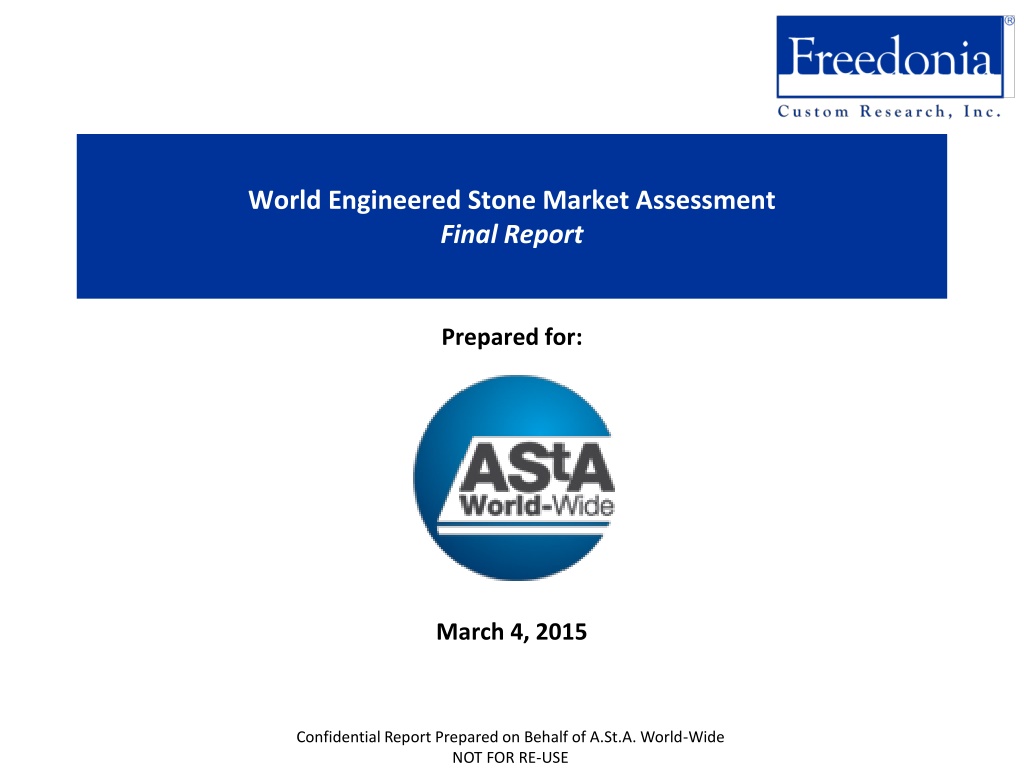
 undefined
undefined









![❤[PDF]⚡ Escaping from Eden: Does Genesis Teach that the Human Race was Created](/thumb/21697/pdf-escaping-from-eden-does-genesis-teach-that-the-human-race-was-created.jpg)






